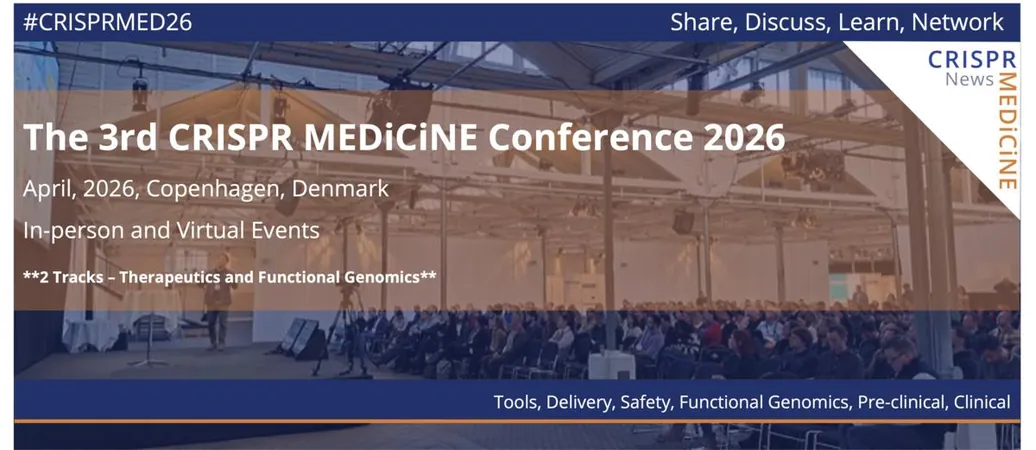
BREAKING: Revolutionary CRISPR Breakthrough Targets UBA5 Gene Defects in Neurons
2025-05-07
Author: Mei
In a groundbreaking study, scientists at St. Jude Children's Research Hospital have pioneered the first-ever patient-derived neuronal model for UBA5-associated encephalopathy, a rare and severe developmental disorder. This condition is infamous for causing significant developmental delays, hypotonia, spasticity, microcephaly, and epilepsy.
New Insights into UBA5 Encephalopathy
The research aims to unravel the disease mechanisms behind UBA5-related disorders and evaluate therapeutic options focused on gene expression. Dr. Heather Mefford, the senior author, emphasizes its significance: "Studying UBA5-related disease in human neuronal cells is vital for identifying disease-relevant changes and testing therapeutic strategies."
Advancing Beyond Traditional Models
Historically, studies have used non-neuronal human cells or animal models. This innovative research instead leverages cortical organoids made from induced pluripotent stem cells sourced from patients with UBA5 genetic variants. This allows a closer look at human-specific neurodevelopmental outcomes.
A Collaborative Effort in Research
Co-lead author Helen Chen, PhD, reflects on the importance of patient involvement: "Neurodevelopmental disorders are notoriously tough to study, especially rare pediatric conditions. Creating an organoid model from patient-derived cells was crucial for testing potential therapies, and we are grateful for our close collaboration with patients and advocacy groups."
Key Findings Reveal Abnormalities in Neuronal Function
The researchers discovered that organoids derived from two patients with UBA5 variants exhibited a significant reduction in GABAergic interneuron populations. These patient organoids were consistently 25% smaller than control samples and demonstrated abnormal neuronal activity, showing increased firing rates but lower network burst frequency.
Exciting Developments in Gene Therapy
Molecular analyses revealed disrupted endoplasmic reticulum (ER) homeostasis in cells with UBA5 variants, leading to heightened unfolded protein responses. To enhance UBA5 gene expression, the team utilized two innovative approaches: SINEUP, which boosts translation via long non-coding RNA, and CRISPRa, a modified CRISPR-Cas9 system to elevate transcription levels. Both strategies led to increases in UBA5 protein abundance and a restoration of ER homeostasis, with SINEUP temporarily correcting abnormal neuronal activity.
A Promising Future for Treatments
"Our findings are incredibly encouraging, especially the potential of SINEUP and CRISPRa as therapies," Dr. Chen states. "Our next steps involve determining the therapeutic window while exploring viable delivery methods."
Harnessing the Genetic Landscape of UBA5 Patients
This research exploits the unique genetic profiles of UBA5 patients, with over 65% possessing the p.A371T variant, which still provides some functional ability. Since individuals with two copies of this variant exhibit no symptoms, augmenting its presence emerges as a promising therapeutic pathway.
Published in Science Translational Medicine on May 7, 2025, this research sets a new precedent in the fight against UBA5-associated encephalopathy, opening doors to targeted therapeutic strategies that could revolutionize treatment options for affected patients.


 Brasil (PT)
Brasil (PT)
 Canada (EN)
Canada (EN)
 Chile (ES)
Chile (ES)
 Česko (CS)
Česko (CS)
 대한민국 (KO)
대한민국 (KO)
 España (ES)
España (ES)
 France (FR)
France (FR)
 Hong Kong (EN)
Hong Kong (EN)
 Italia (IT)
Italia (IT)
 日本 (JA)
日本 (JA)
 Magyarország (HU)
Magyarország (HU)
 Norge (NO)
Norge (NO)
 Polska (PL)
Polska (PL)
 Schweiz (DE)
Schweiz (DE)
 Singapore (EN)
Singapore (EN)
 Sverige (SV)
Sverige (SV)
 Suomi (FI)
Suomi (FI)
 Türkiye (TR)
Türkiye (TR)
 الإمارات العربية المتحدة (AR)
الإمارات العربية المتحدة (AR)